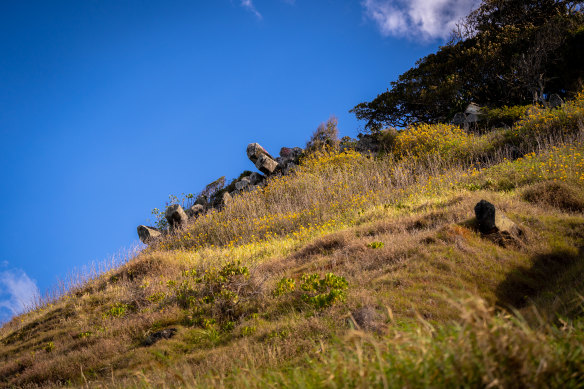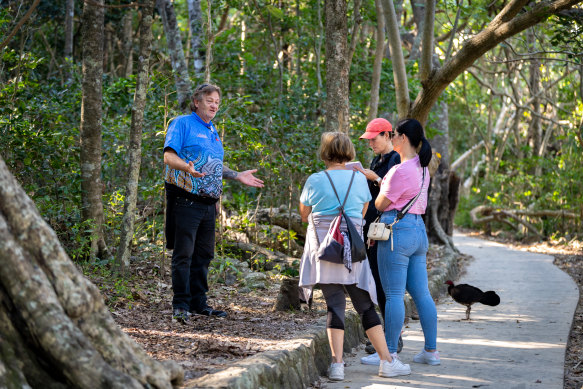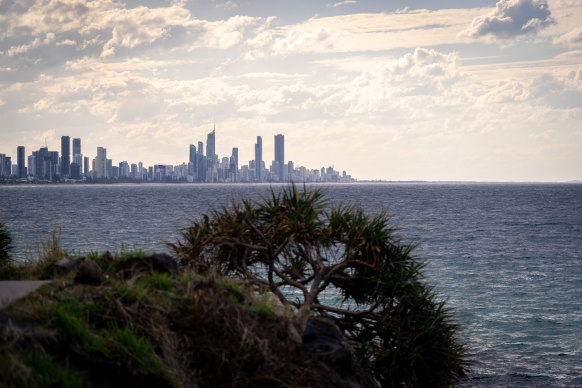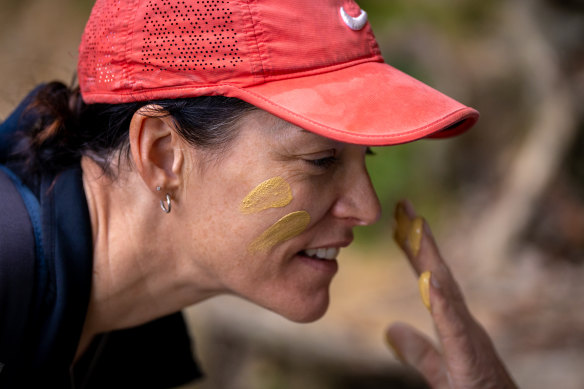This was published 1 year ago
Beyond the high rises: The deep history of the Gold Coast
In a green refuge amid the Gold Coast skyscrapers there’s a landmark that predates the resorts and theme parks. Composed of basalt and littoral rainforest, the viridescent hump of Burleigh Head/Jellurgal protrudes out into the sea, squeezed corpulent between the northern surf breaks and Tallebudgera Creek.
This protected pocket of vegetation is one of the last remaining coastal rainforests in a region where “gold” has gradually supplanted green. It’s also a significant site for the Yugambeh Language People, whose creation stories speak of an ancient landscape formed not by concrete, glass and steel but by a greedy giant spurned.
“Look, can you see the fingers?” First Nations guide Jason Passfield asks, as we stand at the tip of the headland, gazing up at a knot of rocks teetering above a carpet of quivering grass. Poking out from the craggy knuckle, a cylindrical rock points – canon like – out across the ocean. This, Passfield explains, is the index finger of Jabreen, the giant, long-haired creation spirit who rests here.

‘Can you see the fingers?’ Ancient signs in the headland.
A sea eagle (mibunn) wheels overhead as Passfield details how Jabreen created the mountain we stand upon. The land here was once flat and covered with bees’ nests, he says. After feasting greedily on the honey, Jabreen swam out to the horizon to wash off the sticky debris and, returning tired, fell into a deep sleep.
Mother Nature punished his gluttony, and Jabreen woke to discover the ground opening up beneath him, great boulders dragging him down. Jabreen subsequently turned into rock, his fingers visible where he tried to claw his way out.
Most sun-seeking Australian holidaymakers could name at least one theme park on the Gold Coast. And all could identify the high rise-hemmed curves of Surfers Paradise, but few know the region’s oldest creation stories and their significance to the Yugambeh People.

First Nations guide Jason Passfield walking with the group through the rainforest.
At Jellurgal Aboriginal Cultural Centre, Traditional Owners are quietly sharing their culture and stories and connecting visitors to Country, in a destination not renowned for Indigenous tourism.
“First impressions, or even perceived knowledge of the Gold Coast, is generally that it is a new city, bright and busy,” says Kieran Chilcott, of not-for-profit parent organisation Kalwun Development Corporation.
“Our tour shows visitors that there is much more to the Gold Coast; a deep history of culture and tradition that has been proven … to date back thousands of years.”
All proceeds from Jellurgal Walkabout tours go towards funding health and community programs at Kalwun. The tours start at the base of Jellurgal – under the eye of another, distant Dreaming mountain, Wollumbin (Mount Warning).

The tour shows there’s more to the Gold Coast that glitz and high rises.
Inside the reserve (Burleigh Head was thrice earmarked for development before being gazetted a national park in 1947), we stop at an embankment flecked with shells. Carbon dated at 4000 to 5000 years old, the midden is a window into a culture of subsistence living that thrived here for millennia.
On the beach, Passfield tells the story of Gowonda, a great hunter with long white hair and a beard, who returned to Tallebudgera Creek as a white-finned dolphin, herding fish into rock traps for the Yugambeh. Those fish traps can still be seen today, beside the bridge where the bustling Gold Coast Highway crosses the water.
We learn how pandanus leaves were woven to make fishing nets and dilly bags, and how the fibres were fashioned into fishing line and twine to build huts. The pandanus fruit is edible and tastes like mango, Passfield says, but it’s highly coveted, so there’s slim (ripe) pickings on the mountain.
At an ochre vein on the hillside, Passfield mixes the crushed powder with water and daubs two mustard streaks across my cheekbones. This is a signal to the ancestors that I have been welcomed to Country. As I leave Jellurgal and am cast back into the din of highway traffic, it’s also a signal to tourists that there’s more to see on the Gold Coast beyond the high-rise.

A welcome to Country for the writer.
The Details
Tour
Jellurgal Walkabout tours run on Saturdays and selected weekdays. Adults $39 a person, kids $20, bookings essential. See jellurgal.com.au
Stay
Ultiqua Signature is a new resort and residential tower situated close to the beach in fashionable Broadbeach, about 8 kilometres north of Burleigh Heads. The resort has self-contained suites ranging from one to four bedrooms, a 50-metre infinity pool, steam room and sauna. Rooms from $300 a night, minimum two-night stay. See ultiqasignature.com.au
The writer was a guest of Destination Gold Coast. See destinationgoldcoast.com
Sign up for the Traveller Deals newsletter
Get exclusive travel deals delivered straight to your inbox. Sign up now.